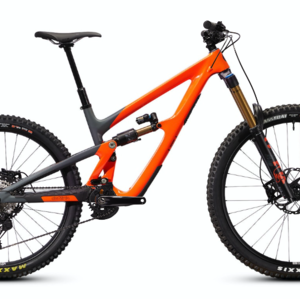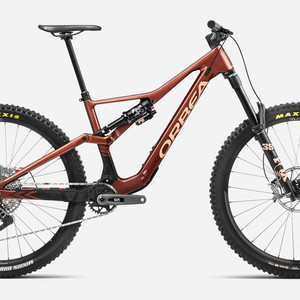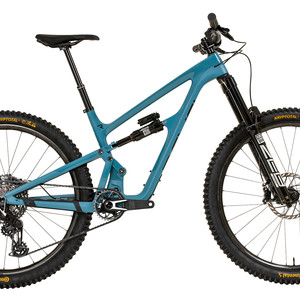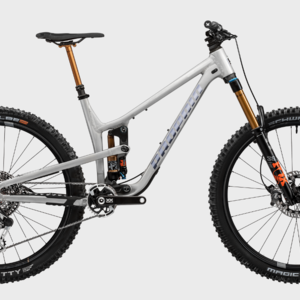2021 Alchemy Arktos 150 X01 29 Bike
(discontinued)
| Where To Buy | |||
|---|---|---|---|
Free shipping on orders over $50 (continental U.S. only).
International shipping available. Some exclusions apply. |
|||
Free shipping on orders over $50 (continental U.S. only).
International shipping available. Some exclusions apply. |
|||

Last season, we had the opportunity to swing a leg over the Alchemy Arktos 29. It had some good qualities, but it left us feeling that there was more potential there and we hoped to see an updated version before too long. Fast forward a year or so and we’ve got our mitts on the updated Arktos 150, sporting similar travel numbers and aesthetics to the previous version, but with a pile of incremental improvements, including geometry, which we felt were lacking in the previous generation. We’ve been riding the Arktos 150 throughout the spring and summer, and believe that Alchemy may be in line for “most improved” in recent memory.
Strengths
| Weaknesses
|
Highlights
- 170mm front travel, 150mm rear travel
- 29-inch wheels (tested)
- Mixed, 29-, 27.5-inch wheel option available
- Sine Suspension System
- Fully triangulated rear swingarm
- In-house paint
- Fully guided internal cable routing
- Custom-tuned FOX suspension
- Threaded bottom bracket
- Available in size medium through extra large
- Limited lifetime warranty
- MSRP $7,399 USD
Sine Suspension System
At the heart of the Alchemy Arktos 150 is David Earle’s patented Sine Suspension. Our initial experience aboard an Alchemy was all positives in terms of suspension performance, so we were pleased to see that they haven’t deviated from this design. This short, dual-link linkage is Alchemy’s preferred layout since it can be effectively tuned for a wide variety of applications, ride qualities, and rider preferences. The similarities between all three Arktos bikes confirm the versatility of Sine Suspension.

Part of what makes the Sine System unique is that it was designed with kinematics and the whole bike in mind, rather than as a compartmentalized system chosen after much of the frame qualities had been designed. In other words, Earle brainstormed the holistic qualities that he wanted first, then worked backward to create the suspension and frame layout to allow them. The upper-link is typical of many designs. Meanwhile, the lower link actually rotates in both directions as travel is utilized, a more unique trait that allows shock rate and kinematics to be ideally tuned throughout the bike’s travel.

The term “Sine” is fitting as the shock curve matches the shape of a single wavelength mathematical sine graph. The shock rate is regressive to begin for small bump compliance, progressive at the mid-stroke for a lively feel, and regressive near end stroke to allow travel to be fully utilized and further refined as needed with volume spacers. As we noted in our first Alchemy review a changing shock rate is common, where a design that changes twice is still unique. All of this can be further refined through suspension tuning and thankfully the Arktos 150 is compatible with both air and coil shocks. However, the regressive end stroke is ideal for air shocks, which are inherently progressive. In the end, Alchemy believes all of these pieces allow for the most versatile, well-rounded bikes on the market. Because of our positive experience with the old Alchemy’s suspension we were confident that this version would be great too, it was the bike’s updated geometry that we were more interested in.
Geometry
The one major issue we took with the outgoing Artkos 29 was the geometry. It felt cramped, tall, and skittish compared to the other bikes we were riding at the time, and while the suspension was great. we never got comfortable on the bike. Fortunately, the new Arktos 150 features a number of geometry improvements, including more reach and a lower stack height to provide a far more modern feel.

The shorter seat tube offers more for long-travel dropper posts and Alchemy even managed to squeeze a water bottle within the front triangle, which is a must-have for many riders. All of the more significant changes above are complemented by smaller, incremental updates to seat tube and head tube angles, chainstay length, and bottom bracket drop. On paper, the new Arktos 150 offers a far more modern riding position, which we felt would completely change our perceptions of the bike.

Initial Impressions
For us, this review was very much centered around a comparison between old and new. Most brands make incremental changes to their bikes every few years, so we appreciated having the opportunity to test the old and new versions in the same calendar year while our experience with the outgoing bike was relatively recent. As we noted, there was a lot to like about the old Arktos, but the geometry was dated. Fortunately, the updated Arktos 150 has 23mm more reach than the old version and a much lower front end, having lost 16mm of stack height. Every single number and angle has been modernized for the latest generation of Arktos. While the geometry isn’t pushing boundaries, it is a significant step in the right direction and should allow the Sine Suspension to truly shine, as geometry was a limiting factor with the outgoing model.

When we swung a leg over the updated version, the improved riding position and geometry were immediately evident. Our new Arktos 150 had the same great suspension feel, but significantly improved geometry and riding position. We happily put our water bottle inside the front triangle and rolled out of the garage to put it to work.


On The Trail
Within a few minutes of hitting the dirt, it was clear that the new Arktos 150 was a different, better animal.Climbing manners are excellent. The Arktos 150 is a more efficient climber than most enduro bikes we’ve tested, without feeling harsh on technical climbs. Even without a lockout lever, we found climbing to be less draining compared to a number of similarly specced enduro bikes, which left us with more gas in the tank for descending. The climbing position isn’t quite as upright as bikes with steeper seat tube angles, so taller riders may choose to move the saddle forward to compensate. Climbing manners strike an excellent balance between efficiency and traction, and we found that regardless of the situation the bike was a capable, efficient climber that outshines the majority of 150mm bikes we’ve ridden. The Sine Suspension is supportive under sag and pedaling, but not so firm that seated technical climbing is harsh or difficult to maintain traction. Our Arktos 150 came with single-ply tires and a sensible build, so the relatively low weight also made life easier. Overall, the suspension, geometry, and weight made climbing a breeze.

The old Arktos wasn’t a great descender. Thankfully, the updates we previously mentioned were most evident when we pointed the bike downhill, and this is undoubtedly the biggest area of improvement for the 150. While a 10mm travel bump and updated kinematics add to the formula, the geometry adjustments were most obvious. The longer wheelbase and reach, plus a lower stack height make for a much improved descending position. They haven’t been changed to a point where the Arktos loses the agility that we enjoyed with the previous version, but enough that we felt “in” versus “on” the bike. Rider position is now central, where it should be, but the numbers aren’t sprawling to a point where movements need to be exaggerated in order to move the bike without huge rider inputs. Pedal feedback is minimal and we had no problem keeping our feet planted while riding flats. We found that we could ride this bike far more aggressively than the previous Arktos, without the loss of playfulness, even at modest speeds. While it remains more of an all-mountain bike, the Alchemy Arktos 150 is now a capable race bike, and wouldn’t be out of place for occasional lift-accessed riding.
Regardless of the ride, the Arktos handled whatever we threw at it
While it descends much better than the old Arktos, the new 150 still shines on moderate, rolling terrain. Just like its predecessor, this bike is more about versatility than a single-minded application, with the caveat that this version is better in every respect. Regardless of the ride, the Arktos handled whatever we threw at it, be it technical descending or rolling cross country, high speed or low. Our X01 build was durable without being overkill for lighter duties. While we often opt for dual-ply tires on our personal bikes we had no issues with Maxxis’ EXO casing, nor did our rims suffer too many knocks. Alchemy has done a great job of moving this bike in a positive direction without reinventing the wheel or compromising on their belief that a long-travel bike can remain efficient and lively in all types of terrain.

The Arktos 150 was fun to ride everywhere. While smaller and larger bikes outshone it in their respective domains, very few bikes can match the versatility of this bike. While there may be more efficient trail bikes and more capable enduro bikes, few have struck the balance as well as the Alchemy Arktos 150. The bike remains more compact feeling than most bikes we’ve ridden recently, but it has enough wheelbase and reach that it can be ridden at speed without feeling twitchy. The lightweight, efficient platform, and playful nature offer an energetic, sporty feeling bike that shines on trails full of corners and rollers where agility is essential. While those who ride big mountains and chair lifts may lean towards something more gravity-oriented, self-propelled riders looking for a versatile, agile option with a boutique feel should take a close look at the Arktos 150.

Build Kits, Pricing & Availability
Alchemy Bicycles remains a direct-to-rider brand. Rather than heading to your local bike shop, you can hop online and chat directly with Alchemy’s sales team to determine the model, build kit and rear wheel size that suits your needs. All three build kit options have similarities: they all feature high-end FOX suspension, Industry Nine wheelsets, and Tag Metals cockpits. Riders can then choose from a more affordable SRAM GX build, a slightly pricier Shimano XT build, or a top-shelf SRAM X01 setup similar to our test bike. Suspension tuning is straightforward. Once we had our rear sag set it took very little to get our Arktos 150 firing on all cylinders, and the FOX 38 fork is obviously an excellent partner for the rear. Because they’re a direct-to-rider brand, Alchemy makes sure that final assembly is a breeze. Packaging and the final nuts and bolts are well-organized, easily installed, and straightforward. Those who aren’t as confident can also rely on Alchemy’s excellent customer service team to walk them through the process.
Check out the complete Alchemy Arktos line in our Product Guide.


Things That Could Be Improved
Alchemy has made improvements across the board with this version of the Arktos 150. The same attention to detail that we noted with the first generation of the Arktos remains, with the core requirements of an excellent long-travel trail bike also being addressed. After months of riding, every component is running as it should, paint has held up well, and we have nothing but praise for this bike. On paper, this bike may seem similar to the previous version, but in reality, the incremental improvements have made for a completely different and much better bike.
One item that could be addressed for subsequent generations of the Arktos 150 is size-specific chainstay lengths to ensure that ride qualities and geometry are maintained across all sizes. The Arktos 150 is only available in medium, large, and extra-large for now too, which means prospective buyers on the shorter side will have to look elsewhere.

Long Term Durability
Because we enjoyed riding the Artkos 150 so much, we put a ton of miles on the bike. We rode the bike in all sorts of weather, and on all kinds of terrain. The part spec on our X01 build has held up well. The Industry Nine Enduro wheelset remains true and relatively dent-free, even with lighter casing tires. The frame and suspension are also running smoothly. Bearings continue to spin freely, the links haven’t collected too much dirt or debris, and our frame only shows a few signs of use thanks to excellent frame protection. We did note that the rear suspension requires more regular torque inspections, however, it only takes a few minutes every now and then.
Our Artkos 150 also developed some lateral play within the suspension linkage, however, it had no impact on ride quality and didn’t worsen. Regardless, we did reach out to Alchemy to address this. Alchemy got right back to us with the following explanation:
"They play you felt is something we identified as one of our washers that came in from the manufacturer at its tolerance threshold. We have actually addressed this so it should be fixed. The bike you were on was one of the first we had come in this year and we caught it early and got new washers that address this. With that fix we have not seen or heard of this being an issue out on the trail from customers."- Alchemy Bikes
Because we've had our test bike for so long, we'll readily give Alchemy the benefit of the doubt on this one and are glad to hear the one issue we had, has since been remedied.
What’s The Bottom Line?
Alchemy Bicycles has made all of the right adjustments to the Arktos 150. The updated bike will appeal to a far more diverse group of riders. It can serve as a long-travel trail bike for those looking for a little more margin for error. The Arktos 150 can also be an enduro race bike for those who favor a sporty, precise ride. Because we had recently ridden the outgoing model, it was also fun to reflect on just how far Alchemy has come with their latest Arktos. The Sine Suspension system and geometry are matched ideally for great performance in every situation, and the small brand feel will appeal to many. Kudos to Alchemy Bicycles for taking something with potential and making something great.
Visitalchemybikes.com to purchase or learn more.
About The Reviewer
Joel Harwood – Age: 38 // Years Riding MTB: 20+ // Height: 5’11” (1.80m) // Weight: 185-pounds (83.9kg)
Joel’s unique coaching background and willingness to tinker with products bring an objective perspective to testing. He dabbles in all types of racing but is happiest simply exploring the limitless trail networks surrounding his home of Squamish, BC. Attention to detail, time in the saddle, and an aggressive riding style make Joel a rider that demands the most from his products while exposing any shortcomings.
Specifications
Rear Wheel: Industry Nine 29 Enduro S Hydra, 30.5mm Width
Rear Wheel: Industry Nine 29 Enduro S Hydra, 6-Bolt, 12x157mm, TA SB+ XD
Rear Wheel: Industry Nine 29 Enduro S Hydra
Rear: Maxxis Minion DHR 29"x2.4" DC/EXO/TR
- Dual-linkage Sine Suspension system
- Three different travel configurations possible with one frame
- Low-standover and modern geometry
- 29" and mixed-wheel 29"/27.5" (mullet) compatibility
| Where To Buy | |||
|---|---|---|---|
Free shipping on orders over $50 (continental U.S. only).
International shipping available. Some exclusions apply. |
|||
Free shipping on orders over $50 (continental U.S. only).
International shipping available. Some exclusions apply. |
|||

























13 comments
Post a reply to: Tested - 2021 Alchemy Arktos 150